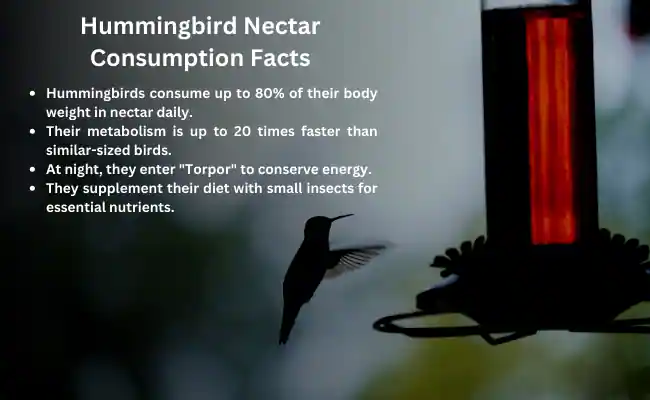Did you know that hummingbirds consume up to 80% of their body mass a day in nectar?
You must have noticed that hummers are always on the go, and that is because of their fast metabolism. Hummingbirds are pure delight, with shimmering colors and wings beating up to 80 times a second.
Their love for nectar isn’t merely because it tastes good but it’s a matter of survival for them. Hummers require a constant supply of energy because they have fast wing flapping and high heart rates.
Nectar provides the necessary fuel for their energetic activities. Hummingbirds would struggle to hover mid-air or zip around at incredible speeds without sufficient nectar. Nectar doesn’t fulfill all their nutritional needs, they also supplement their diet with insects.
It is a valuable source of protein and other essential nutrients. I always wonder what’s special in the nectar and insects that constantly provide energy to these mini helicopters.
How Much Do Hummingbirds Eat?
Hummingbirds are like high-performance racing cars, they need constant refueling. According to Robert Dudley, professor of integrative biology at UC Berkeley, a hummingbird’s daily nectar consumption is about 80% of its body weight.
A hummingbird visits almost 1,000 to 2,000 flowers per day. They drink nectar from flowers and sugar water for energy. Nectar-rich tubular flowers like bee balm, salvia, coral honeysuckle, and fuchsia are favorites of hummingbirds.
In addition to nectar, they also love to drink water from natural sources such as puddles, bird baths, or fountains. Staying hydrated is essential for their well-being.
Hummingbird’s High Metabolism and Energy Needs
Their metabolism operates at breakneck speed, up to 20 times faster than that of an average bird of similar size. When a hummingbird is hovering with its heart beating more than 1,000 times a minute, it burns more energy, than any other bird or mammal.
Hummers need to visit nectar stations every 10-15 minutes without resting. So how do they sleep?? They would starve to death if they weren’t getting nectar every half an hour. Actually, at night their metabolism slows down and they sleep in a state that is called “Torpor” to conserve their energy.
Torpor
At night, the it’s heartbeat and body temperature decrease a lot. This means it’s using only 1/50th of the energy it would use if it were flying around during the day. Hummingbirds burn between 6,600 to 12,000 calories every day. If a man had the same fast metabolism as a hummingbird, he would need to eat nearly 300 pounds of hamburger every day to live.
Unlike many other birds, hummingbirds keep their body temperature high even when they’re resting. Their internal temperature stays around 104°F (40°C). This warmth helps their muscles work well and keeps their metabolism running smoothly.
Do Hummingbirds Eat Insects?
Although nectar constitutes most of their diet, they do eat small insects like fruit flies, mosquitoes, and gnats. They may also consume insect larvae and eggs found on leaves or flowers. Interestingly, hummingbirds take a significant portion of their water intake from the insects they consume.
Insects provide essential nutrients that nectar alone cannot deliver. Protein and fat are crucial for proper muscle development and overall survival. Entomologist Doug Tallamy of the University of Delaware says that “hummingbirds like and need nectar but 80 percent of their diet is insects and spiders.”
Why Nectar is a Constant Source of Energy for Hummers?
Do you know how hummingbirds zip around so quickly? Well, they get all that energy from nectar, the sweet liquid inside flowers. Nectar primarily consists of natural sugars like fructose and glucose. These sugars provide the quick energy hummingbirds need to stay on the move.
But nectar isn’t just sweet it also contains trace amounts of essential minerals such as calcium, iron, and magnesium. These minerals play a fundamental role in hummingbird bodily functions and overall health. Nectar lacks significant protein content, but it does contain small amounts of amino acids. These are essential for basic metabolic activities and growth.

How Nectar Provides Instant Energy?
- Nectar is Readily Digestible: Nectar contains simple sugars, which require minimal digestion. Unlike complex carbohydrates or proteins, these sugars are easily broken down by the hummingbird’s digestive system.
- Fast Absorption: Once ingested, the sugars in nectar are swiftly absorbed into the hummingbird’s bloodstream. Their specialized digestive system ensures efficient uptake. Within just 15 minutes of consuming nectar, hummingbirds’ flight muscles begin burning the sugars they’ve ingested. This quick conversion of nectar into energy enables hummingbirds to sustain their high levels of activity.
- Direct Energy Source: The absorbed sugars enter the hummingbird’s cells and are promptly broken down. This process provides immediate energy for vital functions like flying and maintaining body temperature. According to the research of Kenneth Welch a biology professor at the University of Toronto Scarborough, “Hummingbirds can directly fuel their intense exercise completely with fructose, which is something no other vertebrates can do.”
Conclusion
I love to place hummingbird feeders in my backyard for these tiny jewels. Dozens of them show up in my garden to drink nectar. They are like tiny, busy bees! They zip around all day, and to keep going, they need to drink lots of nectar. It’s like their special super fuel! They drink so much nectar because of their fast metabolism.
Nectar is full of sugar, which gives hummingbirds quick energy to fly and stay warm. They also eat tiny bugs sometimes, like snacks, to get other nutrients they need. At night they enter an energy-saving mode.
Have you ever observed these tiny dynamos in your backyard or garden? Share your experiences and any interesting facts you’ve learned about hummingbirds in the comments below.



